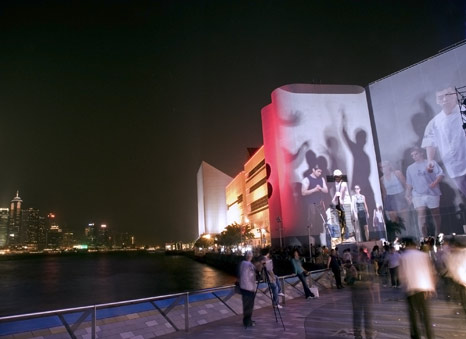[from “ALIEN RELATIONSHIPS FROM PUBLIC SPACE: A winding dialog with Rafael Lozano-Hemmer” by Alex Adriaansens and Joke Brouwer, published in the book Transurbanism, 2002]
My work is best situated somewhere between architecture and the performing arts. For me it is a priority to create social experiences rather than to generate collectible objects. The making of a piece itself is closer to developing a performance or a play than a visual artwork. For the most part, I work with my long-standing collaborator Will Bauer, but also with photographers, programmers, architects, linguists, writers, composers, actors or other staff that may be needed depending on the project.
Most of our work has been developed in media arts contexts, and within this I prefer collective experiences rather than using individual interfaces for solitary participation. In 1989 I interviewed Robert Lepage, the Canadian theatre director, about the impact of technology on the arts. He said, “computers can communicate very efficiently; but they can’t engage in communion”. I think he used the word communion not in its religious connotations but more as the acknowledgement of the human complicity that can’t be shared with computers. I find this idea very interesting, not because it sounds like an apology for humanism, which is in a well-deserved crisis, but because I think communication as a concept in Art is overrated and corporate. What’s more attractive is people meeting and sharing an experience, —a simple pleasure that composer Frederic Rzewski calls “coming together”. This concept, at least when referring to coming together in the flesh, is becoming more radical as people do it less and less thanks to telecommunications, urban design, increasing work load demands, and work schedule flexibility, to name a few factors.
I named the series of interventions “relational” in large part because I wanted to avoid using the term “interactive”. This word has become too vague, like “postmodern”, “virtual”, “deconstruction” or other terms that mean too many things and is exhausted. Duchamp said “the look makes the picture” and when we say that every artwork is interactive, the word is not that interesting anymore. Also it sounds too much like a top-down 1-bit trigger button —you push and something happens— which is too predatorial and simple. Of course “relational” is not my term, I read about it in Maturana and Varela’s neurological studies and also the word has been used since the 60s to describe cross-referencing databases. The great Brazilian artists Lygia Clark and Hélio Oiticica also used the term in the 60s to refer to their user-activated objects and installations. “Relational” has a more horizontal quality, it’s more collective: events happen in fields of activity that may have resonances in several places in the network.
“Placelessness” and “multiplace” are terms concerning the condition of the artwork, but also of ourselves, and of architecture. The feeling that you belong to nowhere, and that you belong to many places at the same time. These two things are the same phenomenon. Personally, I live between Madrid, Montreal and Mexico City and yet I feel like a foreigner in all three cities. I now talk about “going back homes”, in plural. The sense of continuity and complicity is created through the persistence of connectivity and dialog with these places. Locality, like Identity, is a performance.
Every city is many cities in one, all of them overlapping and coexisting. I think coexistence is a very important concept. Two years ago I heard Edward Said speak about how he does not believe that the separation of Israel and Palestine, a reterritorialization on the basis of identity, will work. He called this approach “Identitarian”, that is the authoritarianism that comes from identity and the definition of who’s in and who’s out. There have been centuries of coexistence of different religions in the Middle East, and Said stresses that these models of coexistence should be reactivated and somehow be made more heroic. I find that very interesting, this possibility that you have in the same time and place intensely different planes of experience. The planes may be very different, but sometimes a small connection is being made, either locally or temporarily or post-geographically. There’s always seepage between the different levels. We all live in relational space, and time. For me the emphasis is not on the fetish of the structure, on what is top and what is down, it’s more in the interconnection, the relationship between two things, the relationship between our experience and the outside world of constructed, consensual, sensory experience, if it exists at all. For me what’s important is where these worlds meet.
You must be logged in to post a comment.

cheap proxy buy
I found a great…
buy best private proxies
I found a great…